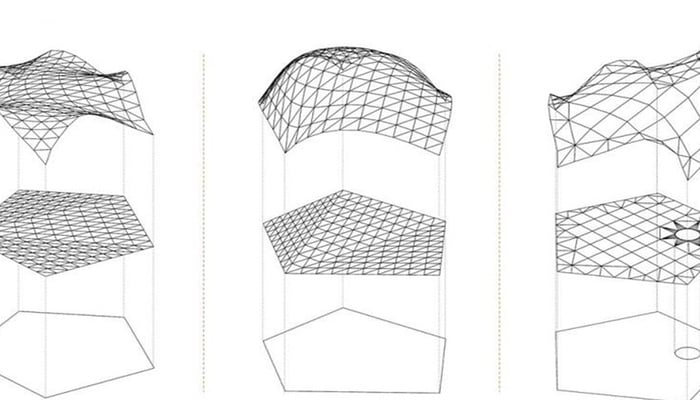Top 3 Ways for Architects to Learn Computational Design in 2025

Table of Contents
Computational Design is a buzzword, taking the Architecture, Engineering, and Construction (AEC) industry by storm. While architects have been using Computer-Aided Design (CAD) for about two decades, the introduction of next-gen Computational Design (CD) promises a brighter future.
What is Computational Design?
Computational Design is a process that harnesses the power of technology, algorithms, and data-driven methodologies to produce efficient building designs. It transcends traditional design methods by enabling architects to leverage advanced software and programming languages to generate, simulate, and optimise intricate structures and spatial solutions. The Guggenheim Museum in Abu Dhabi, The Shard in London, and the Heyday Aliyev Center in Baku are iconic buildings designed and constructed with the help of Computational Design tools.
Read: Understanding Computational Design (The Ultimate Guide)
What are Computational Design Tools?

Computational Design tools encompass an array of software, platforms, and technologies specifically tailored to empower architects for digital design thinking. Architects widely use software such as Rhino and Grasshopper for Computational Design. These tools leverage algorithms, parametric modeling, scripting languages, and data-driven simulations to facilitate the exploration, generation, and refinement of intricate design ideas.
3 Best Ways For Architects To Learn Computational Design
For architects and urban designers, Computational Design will become the way of work in the near future. Hence, it is important that they familiarise themselves with this technology and invest in upskilling. Let’s look at the top three ways professionals can adopt Computational Design in architecture.
1. Formal Education Programs
Enroling in on-campus education programs that offer specialised courses or degrees in Computational Design is a structured and comprehensive way to dive into this dynamic field. Leading universities and institutions worldwide offer courses catering to architects seeking to enhance their Computational Design skills. Through on-campus programs, students learn how to apply computational tools and algorithms to real-world design challenges, enhancing their problem-solving skills and design thinking.
These courses provide a well-rounded curriculum encompassing theoretical foundations, hands-on workshops, and practical applications. For instance, renowned institutions like Columbia University, the Institute of Advanced Architecture of Catalonia (IAAC), and Harvard University offer master's programs that delve deep into Computational Design methodologies. These formal programs provide expert guidance through industry mentors, providing invaluable guidance, feedback, and insights, helping students navigate the complexities of Computational Design effectively. They also foster a collaborative environment, allowing you to network with like-minded professionals and engage in meaningful discourse on the latest trends in the field.
2. Online Courses and Workshops
In today's digital age, the realm of Computational Design is accessible to architects worldwide through a plethora of online courses and workshops. Platforms like Coursera, Udemy, and edX offer diverse courses tailored to varying skill levels. These courses provide the flexibility to learn at your own pace, making them ideal for architects juggling their professional commitments. Participants can access course materials and lectures from anywhere in the world, making learning more convenient than ever before.
Moreover, industry-specific platforms such as Novatr offer dedicated online courses catering to Computational Design enthusiasts. From introductory workshops to advanced masterclasses, architects can choose courses that align with their specific interests and goals within the umbrella of Computational Design. These online resources empower architects to grasp the nuances of parametric modeling, algorithmic thinking, and data-driven design from the comfort of their workspace. Many online courses and workshops emphasise hands-on learning, providing architects with the opportunity to apply theoretical concepts to practical projects.
3. Self-Learning and Experimentation
For architects with a penchant for self-directed learning, the realm of Computational Design offers a vast playground for experimentation. This approach encourages professionals to take initiative, explore various resources, and push their creative boundaries. Combining online resources, tutorials, books, and open-source software tools like Rhino and Grasshopper provides ample opportunities to explore computational concepts at your own pace.
Professionals can engage themselves in self-guided projects that challenge their skills and push the boundaries of their creativity. Collaborating with online communities and forums dedicated to Computational Design, exchanging ideas, and seeking guidance from experienced professionals can also help. By immersing themselves in self-learning and hands-on exploration, architects can gradually build a robust skill set and a unique design language that sets them apart from their peers. Additionally, embracing a trial-and-error approach allows architects to learn from their mistakes and build practical expertise.
How Computational Design Will Change the Way Architects Work?

Computational Design is poised to revolutionise the very fabric of how architects conceptualise, iterate, and bring their visions to life. Architects will transition from conventional manual design methods to harnessing the power of computational algorithms. This will enable them to explore a vast landscape of design variations, optimise solutions, and predict performance outcomes. Additionally, architects will be able to seamlessly integrate environmental, structural, and even socio-cultural considerations into their designs, resulting in structures that are not only visually striking but also ecologically efficient and human-centric.
Why is Computational Design a Good Career Choice For Architects?

Learning Computational Design equips architects with a competitive edge, enabling them to navigate the complexities of modern design challenges. By understanding this cutting-edge technology, architects can broaden their skill set and position themselves at the forefront of architectural innovation, making them sought-after professionals capable of shaping the future of design. Moreover, the demand for architects who understand Computational Design tools is rising. Such professionals find themselves better jobs and earning opportunities.
8 Computational Design Careers for Architects

Given its tech-driven nature, Computational Design offers a multitude of career choices for architects. It allows them to select a vocation that best suits their liking. This allows professionals to carve a better niche in the industry for themselves and lay the foundation for a solid career.
Mentioned below are some of the most promising fields in which architects can invest themselves in
1. Computational Designer
In this niche, architects use computational tools and programming languages to generate parametric models, optimise designs, and develop data-driven strategies.
2. Digital Fabrication Specialist
A digital fabrication specialist combines Computational Design with fabrication technologies such as 3D printing, CNC machining, and robotic assembly to build unique structures.
3. Generative Design Analyst
The job of a Generative Design analyst is to use computational algorithms for optimising designs based on parameters such as aesthetics, functionality, and environmental performance.
4. Sustainability and Performance Consultant
These professionals use simulation software to evaluate how designs respond to environmental factors, enabling them to create energy-efficient and environmentally conscious buildings.

5. Gaming Environment Developer
Architects in this field design immersive virtual environments and interactive experiences using Computational Design principles for gaming and simulations.
6. Parametric Modeller
Parametric Modellers create complex architectural models using parametric design principles. They use software like Grasshopper, Rhino, and Revit to fan their creativity.
7. Smart City Consultant
In this job profile, architects apply Computational Design strategies to develop smart city solutions that enhance urban living through technology and data-driven design.
8. Urban Data Analyst
In this role, architects use computational methods to analyse urban data, providing insights for urban planning and development projects.
Salary of a Computational Designer

The pay scale for computational designers can vary significantly based on factors such as experience, location, industry, and the specific job role. However, let’s look below at the average salaries of computational designers.
-
United States (US)
The average annual income of a computational designer in the US is $95,843.
(Source: Glassdoor)
-
United Kingdom (UK)
A computational designer in the UK can have an average annual earning of £37,947.
(Source: Glassdoor)
In Conclusion
Computational Design is a field ripe with innovation and opportunities in 2024. By enrolling in online courses, engaging with communities, and gaining hands-on experience, you'll learn the intricacies of this exciting discipline and position yourself for success in an ever-evolving industry.
Architects must choose their mode of learning Computational Design with an inherent awareness of their work-life balance. They must select a learning medium that best suits their day-to-day life and allows them to learn at their own pace.
If you are looking for Computational Design courses online, check out the Master Computational Design Course by Novatr. Enroll for the course today!

 Thanks for connecting!
Thanks for connecting!

.png)



-1.png)

